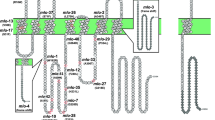Summary
Using a one-step strategy to disrupt CUT1, a gene for cutinase, cut1 − mutants were generated in two strains of Magnaporthe grisea. One strain, pathogenic on weeping lovegrass and barley and containing the arg3–12 mutation, was transformed with a disruption vector in which the Aspergillus nidulans ArgB + gene was inserted into CUT1. Prototrophic transformants were screened by Southern hybridization, and 3 of 53 tested contained a disrupted CUT1 gene (cut1 : : ArgB +). A second strain, pathogenic on rice, was transformed with a disruption vector in which a gene for hyg B resistance was inserted into CUT1. Two of the 57 transformants screened by Southern hybridization contained a disrupted CUT1 gene (cut1:. Hyg). CUT1 mRNA was not detectable in transformants that contained a disrupted gene. Transformants with a disrupted CUT1 gene failed to produce a cutin-inducible esterase that is normally detected by activity staining on non-denaturing polyacrylamide gels. Enzyme activity, measured either with tritiated cutin or with p-nitrophenyl butyrate as a substrate, was reduced but not eliminated in strains with a disrupted CUT1 gene. The infection efficiency of the cut1 − disruption transformants was equal to that of the parent strains on all three host plants. Lesions produced by these mutants had an appearance and a sporulation rate similar to those produced by the parent strains. We conclude that the M. grisea CUT1 gene is not required for pathogenicity.
Similar content being viewed by others
References
Boylan MT, Holland MJ, Timberlake WE (1986) Saccharomyces cerevisiae centromere CEN11 does not induce chromosome instability when integrated into the Aspergillus nidulans genome. Mol Cell Biol 6:3621–3625
Chumley FG, Valent B (1990) Genetic analysis of melanin-deficient, nonpathogenic mutants of Magnaporthe grisea. Mol Plant-Microbe Interact 3:135–143
Dantzig AH, Zuckerman SH, Andonov-Roland MM (1986) Isolation of a Fusarium solani mutant reduced in cutinase activity and virulence. J Bacteriol 168:911–916
Dickman MB, Patil SS (1986) Cutinase deficient mutants of Colletotrichum gloeosporioides are nonpathogenic to papaya fruit. Physiol Mot Plant Pathol 28:235–242
Dickman MB, Patil SS, Kolattukudy PE (1982) Purification, characterization and role in infection of an extracellular cutinolytic enzyme from Colletotrichum gloeosporioides Penz. on Carica papaya L. Physiol Plant Pathol 20:333–347
Fincham JRS (1989) Transformation in fungi. Microbiol Rev 53:148–170
Fotheringham S, Holloman WK (1989) Cloning and disruption of Ustilago maydis genes. Mol Cell Biol 9:4052–4055
Howard RJ, Ferrari MA (1989) Role of melanin in appressorium function. Exp Mycol 13:403–418
Howard RJ, Ferrari MA, Roach DH, Money NP (1991) Penetration of hard substrates by a fungus employing enormous turgor pressures. Proc Natl Acad Sci USA 88:11281–11284
Kolattukudy PE (1985) Enzymatic penetration of the plant cuticle by fungal pathogens. Annu Rev Phytopathol 23:223–250
Köller W, Parker DM (1989) Purification and characterization of cutinase from Venturia inaequalis. Phytopathology 79:278–283
Köller W, Allan CR, Kolattukudy PE (1982) Role of cutinase and cell wall degrading enzymes in infection of Pisum sativum by Fusarium solani f. sp. pisi. Physiol Plant Pathol 20:47–60
Kronstad JW, Wang J, Covert SF, Holden DW, McKnight GL, Leong SA (1989) Isolation of metabolic genes and demonstration of gene disruption in the phytopathogenic fungus Ustilago maydis. Gene 79:97–106
Maiti IB, Kolattukudy PE (1979) Prevention of fungal infection of plants by specific inhibition of cutinase. Science 205:507–508
Miller BL, Miller KY, Timberlake WE (1985) Direct and indirect gene replacement in Aspergillus nidulans. Mol Cell Biol 5:1714–1721
Orr-Weaver TL, Szostak JW (1985) Fungal recombination. Microbiol Rev 49:33–58
Paietta JV, Marzluf GA (1985) Gene disruption by transformation in Neurospora crassa. Mol Cell Biol 5:1554–1559
Parsons KA, Chumley FG, Valent B (1987) Genetic transformation of the fungal pathogen responsible for rice blast disease. Proc Natl. Acad. Sci USA 84:4161–4165
Purdy RE, Kolattukudy PE (1975) Hydrolysis of plant cuticle by plant pathogens. Properties of cutinase I, cutinase II, and a nonspecific esterase isolated from Fusarium solani f. pisi. Biochemistry 14:2832–2840
Rothstein RJ (1983) One-step gene disruption in yeast. Methods Enzymol 101:202–211
Scherer S, Davis RW (1979) Replacement of chromosome segments with altered DNA sequences constructed in vitro. Proc Natl Acad Sci USA 76:4951–4955
Shaykh M, Soliday C, Kolattukudy PE (1977) Proof for the production of cutinase by Fusarium solani f. sp. pisi during penetration into its host, Pisum sativum. Plant Physiol 60:170–172
Shortle D, Haber JE, Botstein D (1982) Lethal disruption of the yeast actin gene by integrative DNA transformation. Science 217:371–373
Staben C, Jensen B, Singer M, Pollock J, Schechtman M, Kinsey J, Selker E (1989) Use of a bacterial hygromycin B resistance gene as a dominant selectable marker in Neurospora crassa transformation. Fungal Genet Newsl 36:79–81
Sweigard JA, Orbach MJ, Valent B, Chumley FG (1990) A miniprep procedure for isolating genomic DNA from Magnaporthe grisea. Fungal Genet Newsl 37:4
Sweigard JA, Chumley FG, Valent B (1992) Cloning and analysis of CUT1, a cutinase gene from Magnaporthe grisea. Mol Gen Genet 232:174–182
Trail F, Köller W (1990) Diversity of cutinases from plant pathogenic fungi: evidence for a relationship between enzyme properties and tissue specificity. Physiol Mol Plant Pathol 36:495–508
Valent B, Crawford MS, Weaver CG, Chumley FG (1986) Genetic studies of fertility and pathogenicity in Magnaporthe grisea. Iowa State J Res 60:569–594
Valent B, Farrall L, Chumley FG (1991) Magnaporthe grisea genes for pathogenicity and virulence identified through a series of backcrosses. Genetics 127:87–101
van den Ende G, Linsken HF (1974) Cutinolytic enzymes in relation to pathogenesis. Annu Rev Phytopathol 12:247–258
Author information
Authors and Affiliations
Additional information
Communicated by C. van den Hondel
Rights and permissions
About this article
Cite this article
Sweigard, J.A., Chumley, F.G. & Valent, B. Disruption of a Maanaporthe arisea cutinase gene. Molec. Gen. Genet. 232, 183–190 (1992). https://doi.org/10.1007/BF00279995
Received:
Issue Date:
DOI: https://doi.org/10.1007/BF00279995




